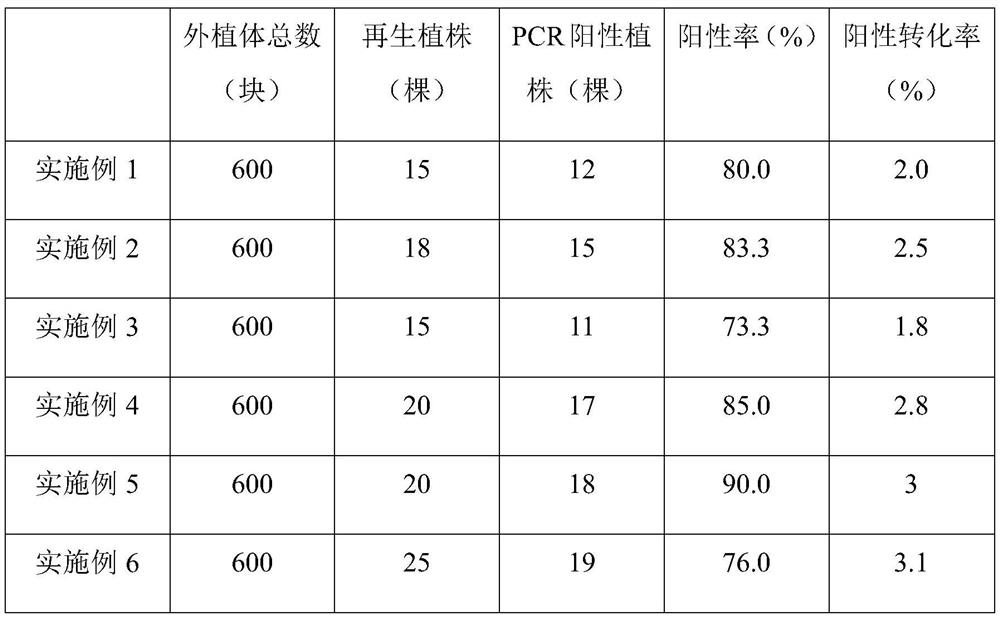Agrobacterium-mediated tomato genetic transformation method
A genetic transformation method and technology mediated by Agrobacterium, applied in the field of tomato genetic transformation mediated by Agrobacterium, can solve the problems of genetic instability of transgenic offspring, affecting the efficiency of genetic transformation, silencing of foreign genes, etc. The effect of genetic stability and expression level improvement
- Summary
- Abstract
- Description
- Claims
- Application Information
AI Technical Summary
Problems solved by technology
Method used
Image
Examples
Embodiment 1
[0064] Embodiment 1: a kind of tomato genetic transformation method mediated by Agrobacterium, specifically comprising:
[0065] Step 1: Planting of sterile seedlings
[0066] 11) In the ultra-clean bench, put a certain amount of Micro-Tom seeds into a sterile plate, pour in 75% absolute ethanol, soak for 5 minutes, discard the solution, add a 4% sodium hypochlorite solution, and soak 5min, discard the solution, wash 5 times with sterile water, and wash the sodium hypochlorite solution to prevent it from affecting the germination rate of the seeds;
[0067] 12) Use sterile tweezers to evenly place the seeds into culture bottles containing T0 medium, 30 seeds in each culture bottle;
[0068] 13) Place it in a dark box and cultivate it for 3 days at a temperature of 25°C until the rooted seeds germinate and the buds grow to 2cm;
[0069] 14) Place the culture bottle of germinated seeds in the cultivation room, and cultivate under light for 2 days at a temperature of 25°C until...
Embodiment 2
[0102] Embodiment 2: Different from Embodiment 1:
[0103] A method for tomato genetic transformation mediated by Agrobacterium, specifically comprising:
[0104] Step 1: Planting of sterile seedlings
[0105] 11) In the ultra-clean bench, put a certain amount of Micro-Tom seeds into a sterile plate, pour in 75% absolute ethanol, soak for 5 minutes, discard the solution, add a 4% sodium hypochlorite solution, and soak 5min, discard the solution, wash 5 times with sterile water, and wash the sodium hypochlorite solution to prevent it from affecting the germination rate of the seeds;
[0106] 12) Use sterile tweezers to evenly place the seeds into culture bottles containing T0 medium, 30 seeds in each culture bottle;
[0107] 13) Place it in a dark box and cultivate it for 4 days at a temperature of 25°C until the rooted seeds germinate and the buds grow to 2.5cm;
[0108] 14) Place the culture bottle of germinated seeds in the cultivation room, and cultivate under light for ...
Embodiment 3
[0136] Embodiment 3: Different from Embodiment 1:
[0137] A method for tomato genetic transformation mediated by Agrobacterium, specifically comprising:
[0138] Step 1: Planting of sterile seedlings
[0139] 11) In the ultra-clean bench, put a certain amount of Micro-Tom seeds into a sterile plate, pour in 75% absolute ethanol, soak for 5 minutes, discard the solution, add a 4% sodium hypochlorite solution, and soak 5min, discard the solution, wash 5 times with sterile water, and wash the sodium hypochlorite solution to prevent it from affecting the germination rate of the seeds;
[0140] 12) Use sterile tweezers to evenly place the seeds into culture bottles containing T0 medium, 35 grains in each culture bottle;
[0141] 13) Place it in a dark box and cultivate it for 5 days at a temperature of 25°C until the rooted seeds germinate and the buds grow to 3cm;
[0142] 14) Place the culture bottle of germinated seeds in the cultivation room, and cultivate under light for 4...
PUM
 Login to View More
Login to View More Abstract
Description
Claims
Application Information
 Login to View More
Login to View More - R&D
- Intellectual Property
- Life Sciences
- Materials
- Tech Scout
- Unparalleled Data Quality
- Higher Quality Content
- 60% Fewer Hallucinations
Browse by: Latest US Patents, China's latest patents, Technical Efficacy Thesaurus, Application Domain, Technology Topic, Popular Technical Reports.
© 2025 PatSnap. All rights reserved.Legal|Privacy policy|Modern Slavery Act Transparency Statement|Sitemap|About US| Contact US: help@patsnap.com


